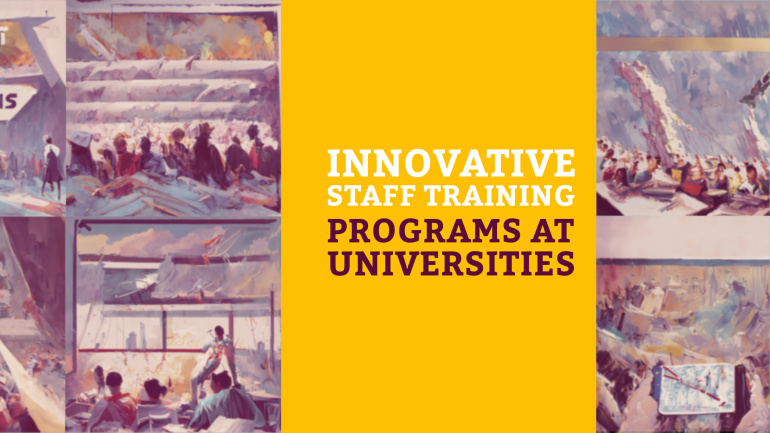This website uses cookies so that we can provide you with the best user experience possible. Cookie information is stored in your browser and performs functions such as recognising you when you return to our website and helping our team to understand which sections of the website you find most interesting and useful.
Table of Contents
TL;DR: Revolutionizing University Success with Innovative Staff Training
- Customized Training: Universities are creating staff training programs tailored to their specific needs and goals.
- Utilization of Technology: Many training programs incorporate online platforms, webinars, and virtual reality to enhance learning experiences.
- Interactive Workshops: Hands-on workshops and group activities are being used to engage staff and promote active learning.
- Focus on Soft Skills: Training programs are placing an emphasis on developing soft skills such as communication, teamwork, and problem-solving.
- Continuous Learning: Universities are implementing continuous learning opportunities to ensure staff stay up-to-date with new trends and advancements.
It’s crucial for universities to have innovative staff training programs to ensure that faculty and staff are equipped with the necessary skills and knowledge to provide quality education and support services to students. These programs go beyond traditional training methods to incorporate cutting-edge techniques that are tailored to the unique needs of higher education institutions.
Theoretical Framework for Staff Development
Adult Learning Theories Relevant to Staff Training
Little research has been conducted on adult learning theories for staff training in university settings. However, principles from prominent theories such as Andragogy and Transformational Learning can be highly applicable to designing effective training programs for university staff. Andragogy, as proposed by Malcolm Knowles, emphasizes self-directed learning and the importance of relevant, practical knowledge for adult learners. Meanwhile, Transformational Learning Theory, developed by Jack Mezirow, focuses on challenging and changing individual beliefs and perspectives through critical reflection and discourse.
Instructional Design Models for Effective Training
For adult learners in university staff training programs, models such as ADDIE (Analysis, Design, Development, Implementation, and Evaluation) and the Action Mapping approach could be beneficial. These models promote a systematic approach to designing and implementing training that aligns with adult learning principles. The use of technology-enabled learning platforms, microlearning, and simulations can further enhance the effectiveness of these instructional design models.
The incorporation of engaging multimedia elements, interactive activities, and real-world case studies into training content can help make the learning experience more interactive and meaningful for university staff members. It is crucial for training programs to be tailored to the specific needs and learning styles of adult learners to optimize knowledge retention and application in their professional roles.
Assessment of Training Needs at Universities
There’s a crucial need for universities to regularly assess and evaluate the training needs of their staff to ensure they are equipped with the necessary skills and knowledge to excel in their roles. This assessment process helps in identifying areas where employees may need additional training or development to enhance their performance and contribute effectively to the institution’s goals.
Identifying Skill Gaps and Training Priorities
With a comprehensive analysis of current skill sets and job requirements, universities can pinpoint the gaps that exist within their staff members. This assessment allows them to determine the critical areas where training is needed the most. By prioritizing training based on these identified gaps, universities can optimize their resources and provide targeted development programs that address the specific needs of their workforce.
Customizing Training Programs to Institutional Goals
On customizing training programs to align with institutional goals, universities can ensure that their staff training is directly contributing to the overall mission and vision of the institution. By tailoring training content to reflect the specific objectives and strategic priorities of the university, employees are better equipped to support the overarching goals of the organization. This alignment helps in fostering a culture of continuous improvement and innovation within the university community.
Assessment: The assessment of training needs at universities is a critical process that can significantly impact the effectiveness and success of staff development initiatives. By identifying skill gaps, prioritizing training areas, and aligning programs with institutional goals, universities can create a robust training framework that enhances employee performance and drives institutional growth.
Innovative Training Methodologies
Technology-Enhanced Learning for Staff
To keep pace with the digital age and evolving educational landscape, universities are increasingly integrating technology-enhanced learning into staff training programs. Technology-enhanced learning utilizes digital tools and platforms to provide interactive and engaging training experiences for staff members. These programs leverage online resources, virtual classrooms, webinars, and mobile apps to deliver training content conveniently and efficiently.
Gamification and Interactive Learning Strategies
Interactive learning strategies like gamification are revolutionizing staff training programs at universities. By incorporating game elements such as point systems, competition, and rewards, universities can motivate staff members to actively participate in training activities. This approach not only enhances engagement but also fosters a spirit of teamwork and collaboration among staff.
Gamification and interactive learning strategies are proven to boost staff motivation and retention of training material. By creating a fun and challenging learning environment, universities can improve staff performance and productivity.
Mentoring and Peer-Learning Approaches
To facilitate continuous learning and professional growth, universities are adopting mentoring and peer-learning approaches in their staff training programs. These approaches involve pairing staff members with more experienced colleagues or peers to share knowledge, provide guidance, and offer support. Mentoring and peer-learning programs create a collaborative environment where staff can learn from each other’s experiences and expertise.
With mentoring and peer-learning approaches, universities can establish a culture of continuous learning and development among staff members. By fostering relationships and connections within the university community, these programs contribute to a more engaged and motivated staff.
For instance, staff members participating in mentoring programs reported higher job satisfaction and increased job performance. By tapping into the collective wisdom and experience of colleagues, staff members can enhance their skills and overcome professional challenges more effectively.
Program Design and Implementation
Creating Curriculum Tailored to University Staff
After thorough research on the specific needs and challenges faced by university staff, an innovative curriculum can be designed to enhance their skills and capabilities. This involves collaborating with academic experts, industry professionals, and experienced trainers to develop courses that are relevant and applicable to the daily tasks of university staff. By tailoring the curriculum to address the unique requirements of staff members, the training programs become more engaging and impactful, leading to improved performance and job satisfaction.
Logistics of Organizing University-Wide Training Initiatives
Creating a university-wide training initiative involves meticulous planning and coordination to ensure the successful implementation of the program. Logistics such as scheduling, venue selection, resource allocation, and participant registration need to be carefully managed to guarantee a seamless training experience for all staff members. Training sessions may need to be conducted in multiple locations to accommodate a large number of participants, requiring effective communication channels and logistics support.
Designing a comprehensive communication strategy is crucial to keep all staff members informed about the training schedule, content, and objectives. Utilizing various communication channels such as emails, newsletters, intranet portals, and social media platforms can help to reach a wider audience and ensure maximum participation in the training programs.
Evaluation and Impact Measurement
Methods for Measuring Training Effectiveness
With the implementation of innovative staff training programs at universities, it becomes imperative to measure the effectiveness of these initiatives. Several methods can be utilized to assess the impact of training on staff development. One common approach is to conduct pre and post-training assessments to track knowledge and skills growth. Surveys and feedback from participants can also provide valuable insights into the relevance and applicability of the training content. Additionally, analyzing performance metrics before and after training can offer concrete data on improvements in job performance.
Long-Term Impact on Staff Performance and University Outcomes
Performance evaluation and impact measurement extend beyond immediate training outcomes. It is crucial to examine how long-term training impacts staff performance and contributes to overall university outcomes. Tracking key performance indicators (KPIs) over time can help identify sustained improvements resulting from training programs. Moreover, analyzing the correlation between staff development and university outcomes, such as student satisfaction levels or research productivity, can provide a comprehensive understanding of the training’s impact on the institution.
LongTerm The long-term impact of staff training programs at universities can be significant, influencing not only individual performance but also organizational effectiveness and reputation. By consistently evaluating the outcomes and aligning training initiatives with strategic goals, universities can ensure a positive and measurable impact on staff development and overall university success.
Professional Development and Career Advancement
Aligning Staff Training with Career Pathways
The implementation of innovative staff training programs in universities is crucial for ensuring the career advancement and professional development of employees. Unlike traditional one-size-fits-all training approaches, universities are increasingly focusing on aligning staff training with career pathways. This tailored approach enables staff to acquire specific skills and knowledge that are directly relevant to their current roles and future career aspirations.
Role of Continuous Learning in Employee Retention
One of the key factors in employee retention is the opportunity for continuous learning and development. Staff members who are provided with opportunities for ongoing training and upskilling are more likely to feel valued and engaged in their roles.
With continuous learning initiatives in place, universities can not only attract top talent but also retain their existing staff by providing them with the tools and resources to grow and advance within the organization.
Challenges and Opportunities
Overcoming Barriers to Staff Participation
Now, let’s address the challenges that universities face when it comes to getting staff to participate in training programs. One common barrier is staff members feeling overwhelmed with their daily responsibilities and not prioritizing professional development. It is crucial for universities to communicate the benefits of training programs clearly and emphasize how it can help staff members grow in their roles and advance their careers.
With effective communication and tailored training schedules, universities can encourage greater staff participation. Providing incentives such as rewards or recognition for completing training modules can also motivate staff to engage in learning opportunities.
Leveraging Resources for Sustainable Training Programs
Programs must strategically leverage resources to ensure the sustainability of training initiatives. By tapping into online learning platforms, universities can offer a diverse range of training options without incurring significant additional costs. Collaborating with industry partners and alumni networks can also provide valuable resources and expertise to enhance training programs.
Participation in external conferences, workshops, and webinars can introduce staff to the latest trends and best practices in their fields, enriching their learning experience and enhancing the overall quality of training programs.
Case Examples of Successful University Training Programs
For universities looking to enhance their staff training programs, it is necessary to learn from successful examples in the field. This chapter will explore some of the most innovative staff training programs implemented by universities and analyze the factors that contribute to their success.
Analysis of Innovative Programs and Their Success Factors
Examples of successful university training programs include customized online modules that allow staff to access training materials at their convenience and interactive workshops that encourage hands-on learning. These programs have been successful due to their emphasis on continuous learning and collaboration among staff members to share knowledge and best practices.
- Continuous learning: Staff are encouraged to engage in ongoing training to keep their skills up-to-date.
- Collaboration: Creating a culture where staff can share knowledge and learn from each other enhances the effectiveness of training programs.
Assume that universities that prioritize these success factors are more likely to see positive outcomes in their training programs.
Lessons Learned and Best Practices
The lessons learned from these innovative training programs highlight the importance of flexibility in meeting the diverse learning needs of staff and the value of measuring the impact of training programs on staff performance and organizational goals. By incorporating these best practices, universities can develop training programs that truly make a difference.
Successful training programs at universities are built on a foundation of continuous improvement and employee engagement. By investing in staff development and creating a culture of learning, universities can cultivate a skilled and motivated workforce that contributes to the overall success of the institution.
Summing up
Now, it is evident that innovative staff training programs at universities play a crucial role in enhancing the skills and capabilities of employees. By incorporating modern learning techniques, utilizing cutting-edge technology, and providing hands-on experiences, universities can ensure that their staff are well-equipped to meet the evolving challenges in the education sector. These training programs not only benefit the individual employees by boosting their professional growth but also contribute to the overall success of the institution by fostering a culture of continuous improvement and innovation.
FAQ
Q: What are innovative staff training programs at universities?
A: Innovative staff training programs at universities are specialized training initiatives designed to enhance the skills and knowledge of university employees, helping them perform their roles more effectively and efficiently.
Q: Why are staff training programs important in a university setting?
A: Staff training programs are crucial in a university setting as they help employees stay updated with the latest trends and advancements in their fields, improve job performance, boost morale, and contribute to the overall success of the institution.
Q: What are some examples of innovative staff training programs at universities?
A: Examples of innovative staff training programs at universities include online learning modules, mentorship programs, leadership development workshops, skill-building seminars, and cross-departmental collaboration initiatives.
Q: How do universities ensure the effectiveness of their staff training programs?
A: Universities ensure the effectiveness of their staff training programs by conducting regular assessments, gathering feedback from participants, tracking performance improvements, incorporating industry best practices, and adjusting the programs as needed to meet evolving needs.
Q: How can university staff benefit from participating in innovative training programs?
A: University staff can benefit from participating in innovative training programs by acquiring new skills, expanding their knowledge base, building professional networks, increasing job satisfaction, advancing their careers, and contributing more effectively to the university’s mission and goals.





